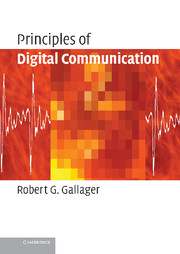Book contents
- Frontmatter
- Contents
- Preface
- Acknowledgements
- 1 Introduction to digital communication
- 2 Coding for discrete sources
- 3 Quantization
- 4 Source and channel waveforms
- 5 Vector spaces and signal space
- 6 Channels, modulation, and demodulation
- 7 Random processes and noise
- 8 Detection, coding, and decoding
- 9 Wireless digital communication
- References
- Index
3 - Quantization
Published online by Cambridge University Press: 05 June 2012
- Frontmatter
- Contents
- Preface
- Acknowledgements
- 1 Introduction to digital communication
- 2 Coding for discrete sources
- 3 Quantization
- 4 Source and channel waveforms
- 5 Vector spaces and signal space
- 6 Channels, modulation, and demodulation
- 7 Random processes and noise
- 8 Detection, coding, and decoding
- 9 Wireless digital communication
- References
- Index
Summary
Introduction to quantization
Chapter 2 discussed coding and decoding for discrete sources. Discrete sources are a subject of interest in their own right (for text, computer files, etc.) and also serve as the inner layer for encoding analog source sequences and waveform sources (see Figure 3.1). This chapter treats coding and decoding for a sequence of analog values. Source coding for analog values is usually called quantization. Note that this is also the middle layer for waveform encoding/decoding.
The input to the quantizer will be modeled as a sequence U1, U2, …, of analog random variables (rvs). The motivation for this is much the same as that for modeling the input to a discrete source encoder as a sequence of random symbols. That is, the design of a quantizer should be responsive to the set of possible inputs rather than being designed for only a single sequence of numerical inputs. Also, it is desirable to treat very rare inputs differently from very common inputs, and a probability density is an ideal approach for this. Initially, U1, U2, … will be taken as independent identically distributed (iid) analog rvs with some given probability density function (pdf) fu(u).
A quantizer, by definition, maps the incoming sequence U1, U2, …, into a sequence of discrete rvs V1, V2, … where the objective is that Vm, for each m in the sequence, should represent Um with as little distortion as possible.
- Type
- Chapter
- Information
- Principles of Digital Communication , pp. 67 - 92Publisher: Cambridge University PressPrint publication year: 2008



